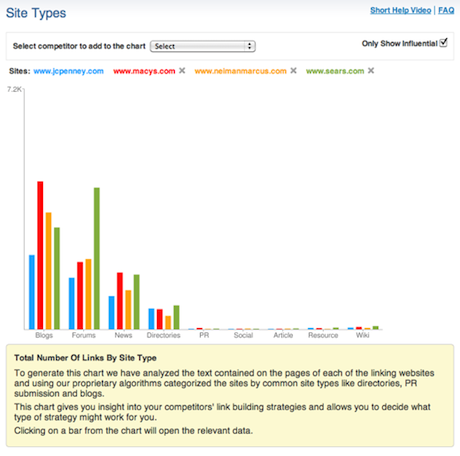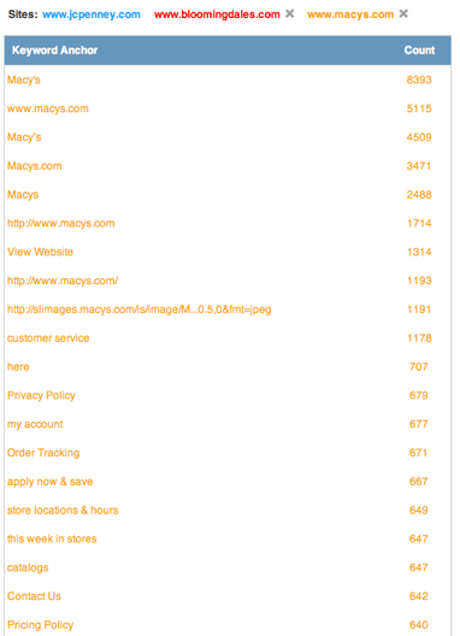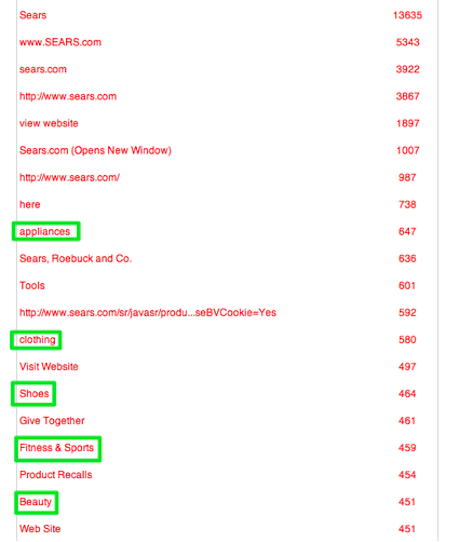What if JC Penney Link Buying is Just the American Way?
British SEO tools company, Linkdex, has released data to Search Engine Watch that suggests, in their assessment, that JC Penney’s link buying strategy was simply just good business sense.
Linkdex (not to be mistaken with Searchdex, the company accused of brokering the links), argues that from their analysis of competitor links JC Penney saw a gap in the market and aggressively chased the opportunity. Perhaps, the SEO should be commended for clearly understanding how Google’s algorithm works, rather than villified for using ‘dirty little secret‘ tactics that are proven to work and generate money? After all, it’s not like anyone can get arrested for buying and selling links. Not yet, anyway.
Running an analysis via their recently launched suite of SEO Tools, Linkdex analyzed the quality of JC Penney’s inbound links against other department stores such as Sears, Neiman Marcus and Macy’s.
Below are some screenshots of the analysis they ran. In a nutshell, what they found is that whilst JC Penney wasn’t the clear winner in terms of volume and quality of links, it was a close second to Sears in terms of it’s overall link building strategy. As many SEOs will probably vouch for, Linkdex’s analysis shows that link anchor text is more important than the overall volume of links.
Put another way, fewer but clearer signposts and search signals is more effective than lots of vague ones.
Link Quality
Google’s mission is to organize the search index according to popularity, authority and influence, and one of the key factors it measures is the number and quality of links to a website. If we use the analogy that websites often represent people or groups, then lots of links from a variety of individuals and groups is likely to be a strong indicator of the popularity of content and the likelihood of that website being an authority on it’s chosen topic.
Therefore the more unique domains that link to you is likely to send a strong signal to Google that your site is popular and authoritative, and thereby, influential. The analysis of Link Quality below shows that Macy’s and Sears in general have from a larger set of domains which contribute a larger total number of links. So, in this analysis both Sears and Macy’s come out the winner.

Type of Links
The Link type analysis below shows that Macy’s and Sears also have links from a better class of site. The worst class of inbound link is from a Made for AdSense site (MFA), and the best tend to be authoritative sites with high traffic or blogs and forums that have a busy and engaged community.

Macy’s Anchor Text Analysis
However, the shine of Macy’s linking strategy starts to fade in it’s anchor text analysis.
Whilst they have garnered a higher volume of better quality links, the search signals those links could provide are not as powerful as they could because the anchor text is not well targeted. A skim read of the results below shows that most of the inbound link anchor text focusses on it’s own brand name, rather than on a generic product description or product brand name.
One might be quick to dismiss this analysis as “all relative”, due to the fact that Macy’s simply has more links and so we might expect it to have a higher concentration of brand focussed links than lesser known sites.
However, the analysis shows that even the site’s own internal link structure could be put to better use. Anchor text such as “Privacy Policy”, “Customer service”, “My Account” and “Order Tracking” suggests that much of the anchor text is being internally generated as other websites are unlikely to link to a site using these terms.
Essentially Macy’s are missing a trick with their internal site structure and footer links are diluting the relevancy of core pages on the site.
Data from the Neiman Marcus website was also provided by Linkdex but findings were much the same as Macy’s, albeit even more heavily focussed on brand name, and so have been omitted from this article.

JC Penney Anchor Text Analysis
However, where JC Penney loses in number of links and quality of those links, it does a little better than it’s competitors with anchor text according to the Linkdex analysis. Although JC Penney also showed a preponderance towards their own navigation showing up as the top anchor text, some keyword rich links do start to show up for words such as ‘shoes’.

Sears Anchor Text Analysis
Of all the sites analyzed, Sears actually had the best balance of keyword rich anchor text. Clothing and appliances appear high on the list. The navigation links show up too but so do a variety of keyword rich terms, most likely from a good navigation design and landing page strategy coupled with good quality external links.
Even Sears have not got it perfect, but as you can see, the real trick is to design your website in such a way that keyword rich anchor text and natural language can be used to create the internal navigation of the site.

He Who Dares Wins?
Like other search engines Google heavily relies on anchor text as a means of calculating the content of a page and it’s topical authority score, as even the overall authority of a link source is not necessarily indicative of it’s relevance to what a page is about. It’s also worth noting that anchor text analysis is not even Google’s algorithm – Teoma was the first to look at it and Google adopted a similar filter within a few months – which suggests that it’s not a problem of relevancy that just Google is having, but endemic to all search engines and search engine design in general.
My point is, there is no “dirty little secret”. It is well known in the SEO community that link counts do not factor nearly as effectively without good quality anchor text. If they did, there would be no need for on-page SEO.
As many SEOs will tell you it’s not always links from the most influential sites that make a difference in the most competitive top three positions. Sometimes a high volume of links from small unknown sites with the right anchor text help the competing site prevail. Often the time spent in soliciting one link from a ‘authoritative’ source is better spent on engaging with the riff raff of lesser known, even unknown, sites. Paying for links has been one shortcut to guarantee the best positioning and the right anchor text, right when you need it.
Paying for links may be a dubious practice with inherent risks, but with the prospect of the biggest online shopping season on the horizon, and a global recession biting on your heels, it’s no surprise that a big brand was willing to take a risk. In this case, after the analysis was done, the only risk was being discovered because every other opportunity in the retail market was ripe for plucking.
It’s beyond the scope of this discussion to question the ethics of paid links themselves (I do have some serious issues about paid link networks), but suffice to say that if the loophole exists, then it will be exploited.
Furthermore, before 2011 there was a strong chance of not getting discovered too as Google’s search result quality was in the sewer. One could argue that JC Penney just got caught in the crossfire of a massive co-ordinated PR campaign against Google’s search quality initiated by a strong group of vested interests.
Presumably every major online retailer is doing competitive analysis on each other’s site design, link structure and inbound link strategy and even a simple analysis as the one above shows that there is plenty to be desired. With obvious weaknesses in Macy’s own strategy it would make sense to go after those markets where they are ranking highly but with no particular strategy to maintain those positions. Often the best way to do that is try to get hundreds of links!
Regardless of JC Penney’s official position on buying links, the SEO in charge, whose work was disclaimed by a JC Penney spokesperson, could, by contrast, be commended. They spotted an opportunity, weighed up the pros and cons (in light of common knowledge of Google’s algorithm) and decided to take it. Google’s results are a zero sum game – there is always a winner and a loser – and competing is the American way!
After all, JC Penney does not owe Google a living just because they send traffic to them. In fact, Google needs JC Penney in it’s index as much as JC Penney needs the traffic. If users turned up and found they couldn’t find JC Penney in the index something would seem amiss in Google’s mission to index all the world’s information. Those users would go elsewhere to find content from major brands. Eric Schmidt was mindful of the symbiosis between brands and Google on the web, and saw it as Google’s mission to clean up the cesspool.
So, whilst Google may swagger about it’s zero-tolerance of black hat practice, it does so, knowing it’s own position is precarious. Which means that for many brands there will still be everything to play for.